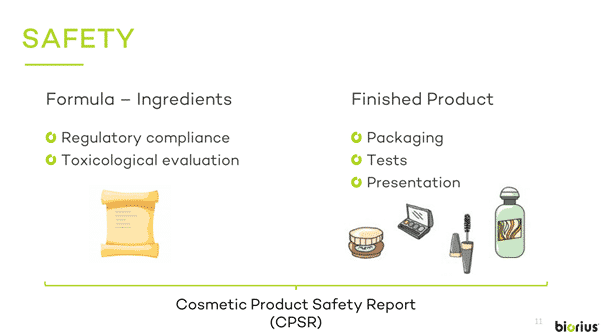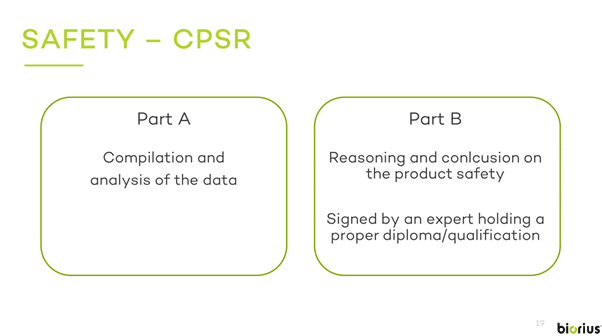There are 4 requirements to Sell in Europe and the UK
CPSR: Before getting to the heart of the matter, it’s always a good practice to remember what is needed in order to sell any cosmetic product in Europe and the UK. As we already mentioned in our article “How to gain EU compliance in three steps”, you must have the following 4 elements:
- CPSR (Cosmetic Product Safety Report) & Product Information File (PIF). For a detailed explanation, please read our article here;
- A compliant label and its claims;
- Notification to the European portal CPNP and to the UK portal SCPN, if you also intend to export and sell your products in the UK;
- The last element is the Legal Representation, i.e., the Responsible Person, based in the EU and the UK, if your cosmetic products are also present in the UK.
If a cosmetics brand that wants to sell in Europe and the UK is missing one of the 4 requirements listed above, we can undoubtedly say that trade is not possible: No market / Unauthorized market / No authorized trade / Pas de Marché / kein Markt / Ningún Mercado / ノーマーケット.
Don’t forget that Biorius can assist you in this process from start to finish, you can find more information about the 5 steps and BIORIUS’ expertise on the EU Regulation here.
Cosmetic Product Safety Report Explanation (CPSR)
This article is intended to provide more clarity and additional information about the Cosmetic Product Safety Report (CPSR). In English, CPSR is also commonly referred to as ‘Safety Assessment‘.

Where can We Find the CPSR?
First, it’s important to know that this document can be found within the PIF of each cosmetic product. Don’t forget that, in practice, the Product Information File is an electronic folder consisting of several subfolders, which contains files, usually PDFs, including also the CPSR.
The Importance of the CPSR and the Inspection of the National Authorities
We might even say that the CPSR is the most important report when placing a cosmetic on the European and UK market. However, we don’t want to take away the importance of the other documents of the PIF. The label and compliant formula, the notifications to the portals and the Responsible Person are also essential elements for full compliance with the European and UK Regulations.
In addition, the CPSR is undoubtedly the document most inspected by the competent national authorities, which is why if there is no trace of the CPSR in the PIF or if you have been negligent in preparing it, this can lead to very severe financial penalties, an immediate withdrawal, and notification to RAPEX. For those who don’t yet know, RAPEX is the EU national Authorities’ supervisory system. Once your cosmetic brand is mentioned to RAPEX, you can expect a systematic and meticulous inspection of all your products…
Which Kind of Information the CPSR must Contain?

In practice, the CPSR consists of two parts, PART A and PART B: the Annex I of REGULATION (EC) No 1223/2009 OF THE EUROPEAN PARLIAMENT AND OF THE COUNCIL of 30 November 2009 on cosmetic products clearly mentions all information that has to be collected and processed by the Safety Assessor in order to identify and quantify the hazards that the cosmetic product may present for human health. In Annex I we find in detail which elements the two parts must contain, namely:
PART A contains cosmetic product safety information, such as:

- Quantitative and qualitative composition of the cosmetic product;
- Physical/chemical characteristics and stability of the cosmetic product;
- Microbiological quality;
- Impurities, traces, information about the packaging material;
- Normal and reasonably foreseeable use;
- Exposure to the cosmetic product;
- Exposure to the substances;
- Toxicological profile of the substances;
- Undesirable effects and serious undesirable effects;
- Information on the cosmetic product.
While PART B includes the cosmetic product safety assessment, namely:
- Assessment conclusion: statement on the safety of the cosmetic product in relation to Article 3;
- Labelled warnings and instructions of use: statement on the need to label any particular warnings and instructions of use in accordance with Article 19(1)(d);
- Reasoning: Explanation of the scientific reasoning leading to the assessment conclusion set out under Section 1 and the statement set out under Section 2. This explanation shall be based on the descriptions set out under Part A. Where relevant, margins of safety shall be assessed and discussed. There shall be inter alia a specific assessment for cosmetic products intended for use on children under the age of three and for cosmetic products intended exclusively for use in external intimate hygiene. Possible interactions of the substances contained in the cosmetic product shall be assessed. The consideration and non-consideration of the different toxicological profiles shall be duly justified. Impacts of the stability on the safety of the cosmetic product shall be duly considered.
- Assessor’s credentials and approval of part B.

Common Mistakes Encountered about CPSR
We would also like to highlight some examples of what common mistakes can be and we may encounter when talking about CPSR:
- The CPSR is only based on the formula composition in ingredients (and not rebuilt from the raw materials breakdown);
- Impurities are not properly identified;
- Nature and evaluation of the packaging material is very limited or even absent;
- Important raw materials documents are missing (e.g., IFRA Certificate of a fragrance);
- Quality of tests is very insufficient or negative test results are ignored or underestimated;
- Toxicological data on individual ingredients is absent or very limited;
- Exposure to the cosmetic product is too optimistic or even completely wrong;
- Only systemic toxicity is evaluated quantitatively (not always well) and no consideration for other toxicological endpoints such as skin sensitization, skin irritation, etc.;
- The Safety Assessor does not have the right qualifications;
- The CPSR is not maintained, made once for all, while it should evolve with the product.
That’s why it’s important to rely on an honest and reliable consultant like Biorius: our Safety Assessors are highly qualified and have obtained the required degrees to fulfill this role and to be able to sign the Part B of the CPSR.
For more information about the CPSR and the services offered by Biorius, please do not hesitate to contact us.
Entra in contatto
"*" indica i campi obbligatori

